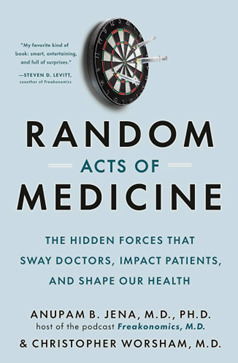Anupam B. Jena and Christopher Worsham. Random Acts of Medicine: The Hidden Forces That Sway Doctors, Impact Patients And Shape Our Health (Doubleday, 2023. ISBN-13: 978-0385548816).
Book Review by Dr. Isabella Watts
 Random Acts of Medicine opens with the line “chance occurrences change the course of our lives all the time.” We can all think of a “sliding door” moment, when our lives could have taken a different route but for a single unforeseen event. But I admit I have never thought about this idea in the context of medical research. The authors, Anupam B. Jena and Christopher Worsham, examine the many hidden forces that affect our healthcare at an individual and systemic level. Although the topic does not produce a single narrative arc, Jena and Worsham explore a wide range of intriguing connections, from whether children with summer birthdays are more likely to get the flu to whether marathons are hazardous for your health. Some of their connections may seem jovial and slight, but the authors use their expertise to explore deeper systemic issues in our healthcare systems. I would recommend this book to anyone interested in healthcare organisations or in using lateral thinking to approach unusual problems.
Random Acts of Medicine opens with the line “chance occurrences change the course of our lives all the time.” We can all think of a “sliding door” moment, when our lives could have taken a different route but for a single unforeseen event. But I admit I have never thought about this idea in the context of medical research. The authors, Anupam B. Jena and Christopher Worsham, examine the many hidden forces that affect our healthcare at an individual and systemic level. Although the topic does not produce a single narrative arc, Jena and Worsham explore a wide range of intriguing connections, from whether children with summer birthdays are more likely to get the flu to whether marathons are hazardous for your health. Some of their connections may seem jovial and slight, but the authors use their expertise to explore deeper systemic issues in our healthcare systems. I would recommend this book to anyone interested in healthcare organisations or in using lateral thinking to approach unusual problems.
Jena and Worsham are two American physicians whose research interests lie in economics and healthcare policy. They focus on natural experiments, a dynamic new field for which researchers David Card, Joshua Angrist and Guido Imbens were awarded the Nobel Prize in Economics in 2021. The concept of a natural experiment sounds deceptively simple, but it can be an incredibly powerful tool if used appropriately. Broadly, such “experiments” are naturally occurring events in which one group is randomly subjected to an event whilst another group is not, therefore the situation forms a natural exposure and control group.
This concept is best explored through an example. We can all remember the smiling politician on their inauguration who becomes grey and worn by the end of their term. Jena and Worsham see this postelection period as a natural experiment since the competing political candidates that previously had identical goals (winning the election) naturally split into two groups with very different exposures (the stresses of the highest political office in the country vs. a regular life). Comparing the winners and the runners up, they found that election winners lived an average of 2.7 years fewer than their opponents. Whilst this result doesn’t show exactly why the election winners age faster, it provides some evidence that winning a major office might be hazardous for your health.
Having explained natural experiments, Jena and Worsham give several fascinating examples within medicine. I will focus on only a few because of their complexity, but readers who are intrigued should see this as a sign to delve into the book. My favourite is the effect of a surgeon’s birthday on their surgical performance. Intense focus is required in the operating room, and surgeons are carefully trained to avoid distractions. But are there surgical risks that we cannot account for? Jena and his team found that the thirty-day patient mortality rate was higher when operations were performed on a surgeon’s birthday compared to any other day of the year. This example highlights the role that an unaccountable distraction can play in medical care. Only when we become aware of such effects can we start to think of ways to overcome them.
In a chapter titled “What Do Cardiac Surgeons and Used-Car Salesmen Have in Common?” Jena and Worsham examine left digit bias. From our daily lives, we are probably aware that we are more likely to buy something that is £7.99 compared to £8.00; this feels like a better bargain than buying something that is £8.00 compared to £8.01. We have all seen this cognitive bias exploited in the supermarket, or (as the authors highlight) when buying a secondhand car. This seems like a minor issue, until you realise that it can affect whether or not someone receives medical care. Jena’s research reveals that doctors perceive a significant difference between patients who are seventy-nine and those who are eighty, which leads to different treatments for these two groups when they present to a hospital with cardiac issues.
As a doctor, I found that this book made me view medical research in a different light, as it takes you away from the lab bench and clinical trials and into the messiness of life. We all have to interact with the healthcare system at some point in our lives, and this book shows that doctors are human and that life is full of surprises. Since reading Random Acts of Medicine, I have found myself contemplating whether there are any interesting natural experiments I could explore, and the authors encourage you to reach out to them if you find any.
Dr. Isabella Watts is an Internal Medicine Doctor training at University College Hospital, London.